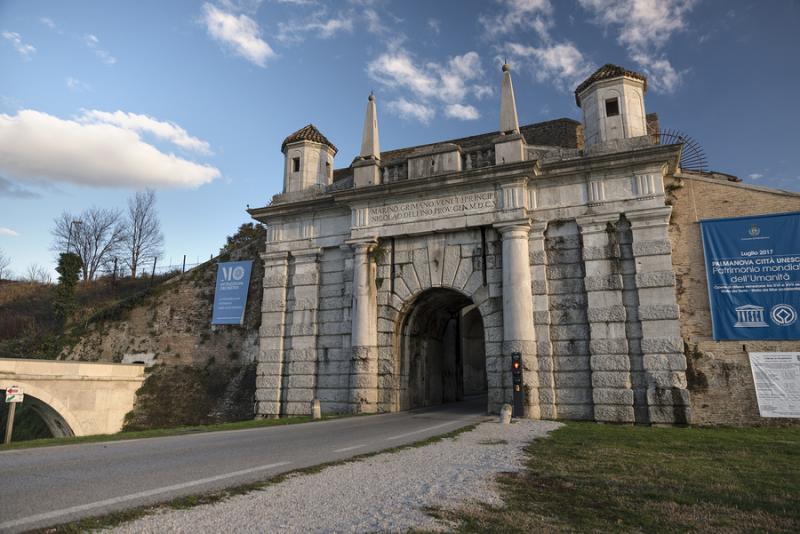Unesco Sites of Italy: Venetian Works of Defence between the 16th and 17th Centuries
ITA:

Use player to listen to Italian version
‘Venetian Works of Defence between the 16th and 17th Centuries’ is a relatively new addition to the list of Italy’s Unesco World Heritage site, having been included in 2017. It is a so-called ‘serial’ site that includes six defense works in Italy, Croatia and Montenegro, which, as Unesco explains, were “necessary to support the expansion and authority of the Serenissima (the Venice Republic).”
These defense systems, which span more than 1,000 kilometers between Lombardy and the eastern Adriatic Coast, protected Venice from other European powers as well as sea routes and ports in the Adriatic Sea.
According to Unesco, they “provide an exceptional testimony of the alla moderna military culture,” which changed with the introduction of gunpowder. The fortified system (bastioned system) built by the Republic of Venice would later be adopted throughout Europe.
Here’s where you can see the “Venetian Works of Defense between 16th and 17th centuries” site (Venice and beyond):
Venice – Darsena Vecchia, Fort of Sant’Andrea, the Porta Nuova tower, Gaggiandre, in the Arsenal; the Poveglia octagon;
Bergamo – the walls of the ‘Città Alta’ constitute the westernmost end of the defense system of land fortifications, built between 1561 and 1588; they replaced some of the still existing sections of ancient Roman walls;
Peschiera del Garda (Verona) – in the southern part of Lake Garda, this small lake town served as a connection between Venice and its westernmost territories and still carries significant traces of its military past as an important defense post for the valley of the Adige and the route to Austria;
Palmanova (Udine) – one of the best preserved examples of military architecture from the Renaissance, Palmanova was built in 1593 to defend the eastern border.
Le ‘Opere di difesa veneziane del XVI° e XVII° secolo’ costituiscono un'aggiunta relativamente recente alla lista italiana di siti Unesco patrimonio mondiale dell'umanità, inserite nel 2017. Si tratta di un cosiddetto sito ‘seriale’ comprendente sei strutture difensive in Italia, Croazia e Montenegro, che, come spiega l'Unesco, furono “necessarie per sostenere l'espansione e l'autorità della Serenissima” (la Repubblica di Venezia).
Questi sistemi di difesa, che si estendono per oltre 1.000 chilometri tra la Lombardia e la costa adriatica orientale, proteggevano Venezia da altre potenze europee, nonché rotte marittime e porti sul mare Adriatico.
Secondo l'Unesco, queste opere “forniscono una testimonianza eccezionale della cultura militare alla moderna”, che si modificò con l'introduzione della polvere da sparo. Il sistema fortificato, o bastionate, introdotto dalla Repubblica di Venezia sarebbe stato successivamente adottato in tutta Europa.
Ecco dove vedere le ‘Opere di difesa veneziane del XVI° e XVII° secolo a Venezia e oltre:
Venezia: Darsena Vecchia, Forte di Sant'Andrea, la torre di Porta Nuova, Gaggiandre, nell'Arsenale; l'ottagono di Poveglia.
Bergamo: le mura della ‘Città Alta’ costituiscono l'estremità più occidentale del sistema di difesa delle fortificazioni di terra, costruito tra il 1561 e il 1588; sostituirono alcune delle sezioni ancora esistenti di antiche mura romane.
Peschiera del Garda (Verona): nella parte meridionale del Lago di Garda, questa piccola città lacustre serviva da collegamento tra Venezia e i suoi territori più occidentali e porta ancora tracce significative del suo passato militare come importante luogo difensivo per la valle dell'Adige e la rotta per l'Austria.
Palmanova (Udine) - uno degli esempi meglio conservati di architettura militare del Rinascimento, Palmanova fu costruita nel 1593 per difendere il confine orientale.











